Swift Advanced Operators
Define custom operators, perform bitwise operations, and use builder syntax.
1. Advanced Operators 👩💻
Swift 는 C나 Objective-C와 유사한 Bitwise Operators를 포함해 여러 고급 연산자를 제공한다. Swift 는
C 의 Arithmetic Operators 와 달리 기본적으로 Overflow 되지 않는다.
Overflow 는 trapped되어 에러로 보고된다.
Swift 에서 Overflow 행동을 하도록 하려면 Overflow Addition Operator($+)와 같은 연산자를 사용해야한다
(모든 Overflow Operators는 &로 시작한다).
Custom Classes, Structures, Enumerations 를 정의할 때, Custom Types 에 대해 Standard Swift Operators 의 구현을 제공하는 것이 유용할 수 있다. Swift 는 Custom Types 에 대해 Custom Operators 를 손쉽게 제공할 수 있도록 하며, 각 Types 에 대한 행동이 정확히 무엇인지 결정할 수 있다.
Custom Operators 는 사전에 정의된 Operators 로 제한되지 않으며, Swift 는 자신만의 Infix, Prefix,
Assignment Operators를 정의함은 물론, 자신만의 우선순위를 자유롭게 정의할 수 있다. 이러한 Custom Operators
는 코드에서 Swift 가 기본적으로 제공하는 Predefined Operators 처럼 사용되며, Custom Operators 를 채택하도록
기존의 Types 를 확장할 수 있다.
2. Bitwise Operators 👩💻
1. Bitwise Operators
Bitwise Operators 는 Data Structure 내에서 개별 Raw Bits를 조작할 수 있게 해준다. 이것은 Graphics
Programming 이나 디바이스 드라이버 생성 같은 Low-Level Programming 에서 주로 사용된다. 또한 외부 소스로부터
Custom Protocol 을 사용해 통신하는 데이터 Encoding/Decoding 작업에 사용하기도 한다. Swift 는 C 가
갖고 있는 모든 Bitwise Operators 를 지원한다.
func printToBinary(number: UInt8) {
print(toBinary(number))
func toBinary(_ number: UInt8) -> String {
let binary = String(number, radix: 2)
if binary.count < number.bitWidth {
return String(repeating: "0", count: 8 - binary.count) + binary
} else {
return binary
}
}
}
위 함수를 만들고 비트 연산 결과를 확인해보자.
2. Bitwise NOT Operator ~
Bitwise NOT Operator ~는 Prefix Operator로 공백 없이 값 바로 앞에 위치해 숫자의 모든 비트를 반전시킨다.

let initialBits: UInt8 = 0b00001111
let invertedBits = ~initialBits
printToBinary(number: invertedBits) // 11110000
UInt8 정수는 8비트를 가지며 0 ~ 255 사이의 숫자를 저장할 수 있으며, 2진수 00001111로 이루어진 8비트 데이터
(10진수로 15와 같음)에 ~ Operator 를 적용해 2진수 11110000(10진수로 240과 같음)이 되었다.
3. Bitwise AND Operator &
Bitwise AND Operator &는 두 값 사이에 위치해 연산된 값을 반환한다. 비트의 각 자릿수가 모두 1이면 1을, 그 외에는
0을 반환한다.
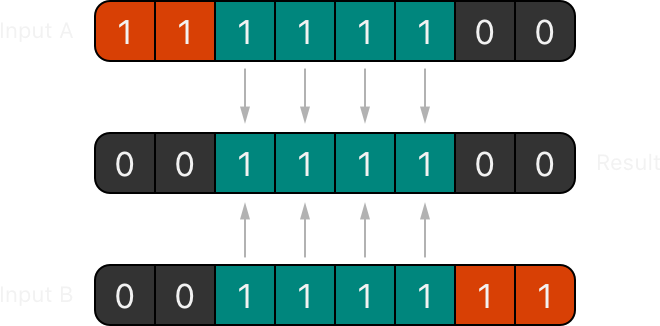
let firstSixBits: UInt8 = 0b11111100
let lastSixBits: UInt8 = 0b00111111
let middleFourBits = firstSixBits & lastSixBits
printToBinary(number: middleFourBits) // 00111100
2진수 11111100과 00111111에 & Operator 를 적용해 2진수 00111100이 되었다.
4. Bitwise OR Operator |
Bitwise OR Operator |는 두 값 사이에 위치해 연산된 값을 반환한다. 비트의 각 자릿수가 모두 0이면 0을, 그 외에는
1을 반환한다.
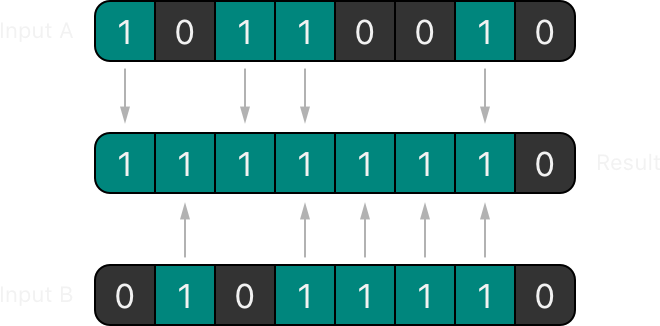
let someBits: UInt8 = 0b10110010
let moreBits: UInt8 = 0b01011110
let combinedBits = someBits | moreBits
printToBinary(number: combinedBits) // 11111110
2진수 10110010과 01011110에 | Operator 를 적용해 2진수 11111110이 되었다.
5. Bitwise XOR Operator ^
Bitwise XOR Operator(=Exclusive OR Operator) ^는 두 값 사이에 위치해 연산된 값을 반환한다. 비트의 각 자릿수가
서로 같으면 0을, 다르면 1을 반환한다.
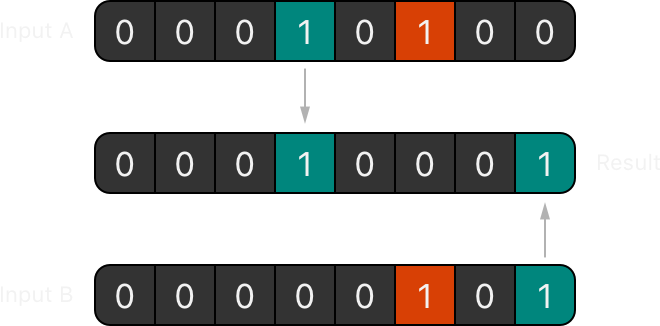
let firstBits: UInt8 = 0b00010100
let otherBits: UInt8 = 0b00000101
let outputBits = firstBits ^ otherBits
printToBinary(number: outputBits) // 00010001
2진수 00010100과 00000101에 ^ Operator 를 적용해 2진수 00010001이 되었다.
6. Bitwise Left and Right Shift Operators << >>
Bitwise Left Shift Operator <<는 모든 비트를 왼쪽으로 이동시키며 정수를 2배로 곱하는 효과가 있고, Bitwise Right
Shift Operator >>는 모든 비트를 오른쪽으로 이동시키며 정수를 반으로 나누는 효과가 있다.
1 ) Shifting Behavior for Unsigned Integers
부호 없는 정수의 Bit-Shifting 행동은 다음과 같다.
- 기존의 비트를 요청된 숫자만큼 왼쪽 또는 오른쪽으로 이동시킨다.
- 정수의 저장 범위(UInt8 정수는 8비트를 가지며 0 ~ 255 사이의 숫자를 저장)를 넘는 비트는 제거된다.
- 비트 이동으로 빈 공간에
0이 삽입된다.

let shiftBits: UInt8 = 4
printToBinary(number: shiftBits) // 00000100
printToBinary(number: shiftBits << 1) // 00001000
printToBinary(number: shiftBits << 2) // 00010000
printToBinary(number: shiftBits << 5) // 10000000
printToBinary(number: shiftBits << 6) // 00000000
printToBinary(number: shiftBits >> 2) // 00000001
다음 예제는 16진수 Cascading Style Sheets 색상값을 각각 RGB 로 분리하는 연산을 수행한다.
let pink: UInt32 = 0xCC6699
let redComponent = (pink & 0xFF0000) >> 16 // redComponent is 0xCC, or 204
let greenComponent = (pink & 0x00FF00) >> 8 // greenComponent is 0x66, or 102
let blueComponent = pink & 0x0000FF // blueComponent is 0x99, or 153
16진수 Cascading Style Sheets 색상값을 저장하기 위해
UInt32상수를 사용했고 저장된 색상은 분홍색이다.
- 빨간색을 분리하기 위해 분홍색에 빨강색의 자릿값
0xFF0000을&연산한 다음 오른쪽으로 16비트를 이동시킨다.- 녹색을 분리하기 위해 분홍색에 녹색의 자릿값
0x00FF00을&연산한 다음 오른쪽으로 8비트를 이동시킨다.- 파란색을 분리하기 위해 파랑색의 자릿값
0x0000FF을&연산했고 자릿값 이동이 필요 없어 그대로 종료했다.
2 ) Shifting Behavior for Signed Integers
부호 있는 정수의 Bit-Shifting 행동은 이진으로 표현되는 방법 때문에 부호 없는 정수보다 더 복잡하다(다음 예제는 단순화를 위해 8비트의 부호 있는 정수를 사용하지만 동일한 원칙이 모든 부호 있는 정수에 적용된다).
부호 있는 정수는 첫 번째 비트를 부호로 사용한다. 이를 Sign Bit로 0은 양수를, 1은 음수를 표현한다. 그리고 나머지
비트는 Value Bits로 실제 값을 저장한다. 양수일 때는 부호 없는 정수와 동일한 방식을 사용한다.

부호 있는 정수의 +4
하지만 음수의 경우 우리가 직관적으로 사용하는 부호 + 절대값 숫자의 형태를 띄지 않는다. +4, -4 이런 식의 표현은 사람에게
쉽고 익숙한 것이지 컴퓨터 친화적이지 않기 때문이다. 컴퓨터는 Binary 로 데이터를 다루기 때문에 2의 보수를 사용해 표현한다.

부호 있는 정수의 -4
2진수가 가질 수 있는 보수는 2의 보수와 1의 보수다.
- 2진수 양수
+4는00000100이다.+4의 1의 보수는11111111 - 00000100=111110110이다.+4의 2의 보수는 1의 보수에 1을 더해111110110 + 00000001=11111100이 된다.
부호 있는 정수의 -4는 Sign Bit 1과 Value Bits 1111100으로 이루어진다. 10진수에서 이 값은 124를 갖는다.
따라서, 부호 있는 정수의 음수 표현은 2의 보수를 사용해 음수를 표현하는 Sign Bit와 2의 보수로 표현되는 Value Bits
128 - 4를 표현 방식으로 사용하고 있음을 확인할 수 있다. 이를 Two's Complement Representation(2의 보수 표현)이라
부른다.
2의 보수 표현을 사용하면 컴퓨터 연산에 여러 장점을 가질 수 있다.
-1+-4와 같은 연산을 단순히 표준 이진 덧셈으로 다룰 수 있다.
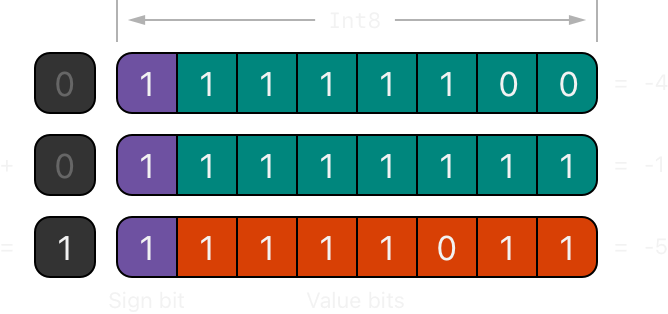
2의 보수로 표현된 -4와 -1을 표준 이진 덧셈 연산을 한 후 정수의 저장소 범위를 넘어 이동된 모든 비트를 삭제하면 손쉽게 -5의
2의 보수 표현을 얻는다.
- Bitwise Shift Operators 를 Unsigned Integers 와 유사하게 다룰 수 있다.

부호 있는 정수의 Bitwise Left Shift Operator 는 부호 없는 정수와 동일하게 행동하며 값을 2배로 늘린다.
부호 있는 정수의 Bitwise Right Shift Operator 는 부호 없는 정수와 유사하나, 비트 이동으로 빈 공간을 0으로 채우는 것이
아닌 Sign Bit 로 빈 자리를 채운다. 이것을 Arithmetic Shift라 한다.
3. Overflow Operators 👩💻
1. Overflow Operators
Swift 는 정수 상수 또는 변수에 저장할 수 없는 값을 삽입하려고 하면, 유효하지 않은 값을 생성을 허용하지 않으며 에러를 발생시킨다. 이러한 행동은 너무 크거나 작은 값을 다룰 때 추가적인 Safety 를 제공한다.
예를 들어 Int16 정수는 2^16 = 65,536 개의 값을 0을 기준으로 저장하므로 -32,768 ~ 32,767 의 값을 저장할 수 있으므로
이 범위를 초과하는 숫자를 저장하려고 하면 에러를 발생시킨다.
var potentialOverflow = Int16.max // 32,767
potentialOverflow += 1 // error, Swift runtime failure: arithmetic overflow
따라서 경계값 조건을 코딩할 때 에러 처리를 제공해 유연성을 높일 수 있다. 하지만 에러를 발생시키는 대신 &를 붙여 Overflow
Operators를 사용할 수도 있다. Swift 는 3가지 Arithmetic Overflow Operators 를 제공한다.
- Overflow addition
&+ - Overflow subtraction
&- - Overflow multplication
&*
var potentialOverflow = Int16.max // 32,767
print(potentialOverflow &+ 1) // -32768
print(potentialOverflow &+ 2) // -32767
print(potentialOverflow &+ 3) // -32766
print(potentialOverflow &- 1) // 32766
print(potentialOverflow &* 2) // -2
2. Value Overflow
숫자는 Positive, Negative 양 방향으로 오버플로우 될 수 있다.
앞에서 정의한 printToBinary(number:) 함수를 다음과 같이 고치고 Overflow Operators 의 동작을 살펴보자.
func printToBinary<T: BinaryInteger>(number: T) {
print("Binary: \(toBinary(number)), Decimal: \(number)")
func toBinary(_ number: T) -> String {
let absoluteNumber = abs(Int(number))
let binary = String(absoluteNumber, radix: 2)
if binary.count < 8 {
return String(repeating: "0", count: 8 - binary.count) + binary
} else {
return binary
}
}
}
다음은 부호 없는 정수의 Positive 방향으로의 오버플로우 발생에 대한 예제다.
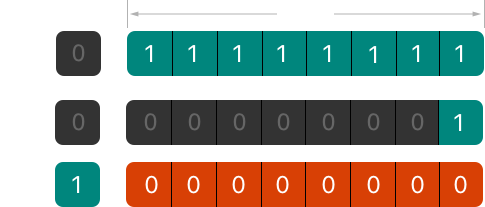
var unsignedOverflow = UInt8.max
printToBinary(number: unsignedOverflow)
// Binary: 11111111, Decimal: 255
unsignedOverflow = unsignedOverflow &+ 1
printToBinary(number: unsignedOverflow)
// Binary: 00000000, Decimal: 0
- 변수 unsignedOverflow 는
UInt8의 최댓값11111111을 초깃값으로 저장한다.- Overflow Addition Operator
&+를 사용해 값을 1 증가시킨다.- 정수의 저장 범위를 넘는 비트는 제거되고
00000000이 남게 된다.
이번에는 부호 없는 정수의 Negative 방향으로의 오버플로우 발생에 대한 예제를 알아보자.
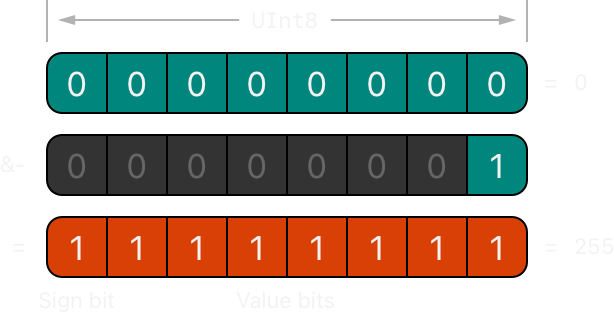
var anotherUnsignedOverflow = UInt8.min
printToBinary(number: anotherUnsignedOverflow)
// Binary: 00000000, Decimal: 0
anotherUnsignedOverflow = anotherUnsignedOverflow &- 1
printToBinary(number: anotherUnsignedOverflow)
// Binary: 11111111, Decimal: 255
오버플로우는 Signed Integers 에서도 발생한다. 부호 있는 정수의 모든 덧셈, 뺄셈은 비트 방식으로 수행된다.
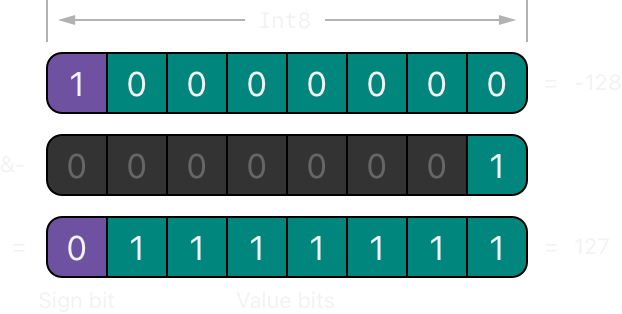
var signedOverflow = Int8.min
printToBinary(number: signedOverflow)
// Binary: 10000000, Decimal: -128
signedOverflow = signedOverflow &- 1
printToBinary(number: signedOverflow)
// Binary: 01111111, Decimal: 127
- 변수 signedOverflow 는
Int8의 최솟값10000000을 초깃값으로 저장한다.- Overflow Subtraction Operator
&-를 사용해 값을 1 감소시킨다.- 결과값은 부호 비트가 토글되어 양수가 되어
01111111을 저장한다.
Signed Intergers, Unsigned Integers 는 동일하게 최댓값을 넘어서면 최솟값으로, 최솟값을 넘어서면 최댓값으로 순환된다.
4. Precedence and Associativity 👩💻
연산자 우선순위(precedence)는 다른 연산자보다 높은 우선순위를 갖도록 해 먼저 적용되게 한다. 연산자 연관성(associativity)은 동일한 우선순위를 갖는 연산자들이 왼쪽과 그룹화 될지, 오른쪽과 그룹화 될지를 정의한다.
Swift 는 C 처럼 Multiplication Operator *, Division Operator /, Remainder Operator % 같은
것들은 Addition Operator +, Subtraction Operator - 같은 것들보다 더 높은 우선순위를 갖는다. 동일한 우선순위
사이에서는 왼쪽으로 그룹화 된다. 즉, 수학적 사칙연산 우선순위를 그대로 따른다.
2 + 3 % 4 * 5
따라서 위 연산은 괄호를 사용해 우선순위를 명시적으로 표현하면 다음과 같다.
2 + ((3 % 4) * 5)
(3 % 4)는 3 이므로 다음 연산은 2 + (3 * 5)가 되고, 또 다시 (3 * 5)는 15 이므로 다음 연산은 2 + 15가 되어
연산 결과는 17 이 된다.
Swift 의
Operator Precedences와Operator Associativity Rules는 C 나 Objective-C 보다 더 간단하고 예측 가능하다. 이것은 C-based 언어와 완전히 일치하지 않음을 의미하므로, 기존 코드를 Swift 로 전환할 때 연산자 상호작용이 의도한대로 작동하는지 확인해야한다. Swift Standard Library 가 제공하는 Operators 는 Operator Declarations 에서 확인할 수 있다.
5. Operator Methods 👩💻
1. Operator Methods
Classes 와 Structures 는 기존 연산자를 Overloading 시켜 자체 구현을 제공할 수 있다.
Arithmetic Addition Operator 는 두 타겟에 작동하므로 Binary Operator이며, 두 타겟 사이에 위치하므로
Infix Operator다. 아래 예제는 Custom Structure 에서 Overloading 을 통해 Arithmetic Addition
Operator +가 어떻게 구현되는지를 보여준다.
struct Vector2D {
var x = 0.0, y = 0.0
}
extension Vector2D {
static func + (lhs: Vector2D, rhs: Vector2D) -> Vector2D {
Vector2D(x: lhs.x + rhs.x, y: lhs.y + rhs.y)
}
}
Vector2D의 Type Method 로 정의된 연산자 +는 이름이 Arithmetic Addition Operator 와 일치하기 때문에
Overloading 된다. Arithmetic Addition Operator 가 Binary Operator 이며, Infix Operator 이므로
이 연산자 역시 동일한 형태로 작성되었다. 또한 덧셈 연산은 벡터의 필수 동작이 아니므로 Structures 정의 자체에 포함시키지 않고
Extensions 를 이용해 분리시켜 정의했다.
let vector = Vector2D(x: 3.0, y: 1.0)
let anotherVector = Vector2D(x: 2.0, y: 4.0)
let combinedVector = vector + anotherVector
print("Combined Vector is (\(combinedVector.x), \(combinedVector.y)).")
// Combined Vector is (5.0, 5.0).
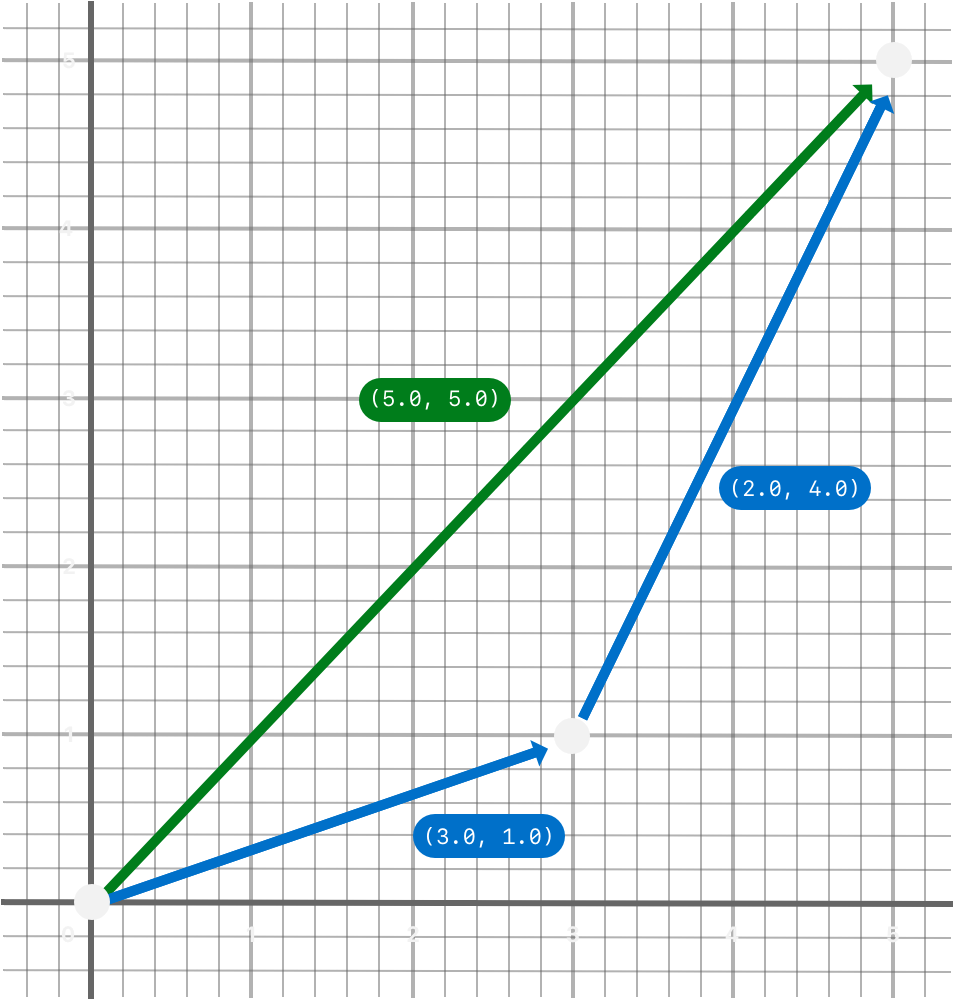
2. Prefix and Postfix Operators
위 예제는 Binary Infix Operator의 Custom Implementation 을 보여주었다. Classes 와 Structures 는
Standard Unary Operators 와 같은 것들도 구현할 수 있다.
Unary Operators
- Single Target 을 대상으로 작동한다.
- Operator 가 타겟 앞에 위치하는
Prefix Operators, 타겟 뒤에 위치하는Postfix Operators2가지로 나뉜다.Binary Operators
- Two Target 을 대상으로 작동한다.
- Operator 가 두 타겟 사이에 위치한다.
Unary Operators는 func keyword 앞에 prefix 또는 posfix modifier 를 작성해 정의한다. 다음 Operator 는
Unary Minus Operator 로 Prefix Operator 로 정의되었다.
extension Vector2D {
static prefix func - (vector: Vector2D) -> Vector2D {
Vector2D(x: -vector.x, y: -vector.y)
}
}
let positive = Vector2D(x: 3.0, y: 4.0)
let negative = -positive
print("Negative Vector is (\(negative.x), \(negative.y)).")
// Negative Vector is (-3.0, -4.0).
let alsoPosotive = -negative
print("Also Positive Vector is (\(alsoPosotive.x), \(alsoPosotive.y)).")
// Also Positive Vector is (3.0, 4.0).
3. Compound Assignment Operators
Compound Assignment Operators는 연산자와 Combine Assignment =를 결합해 만든다. 예를 들어 Addition
Assignment Operator +=는 단일 연산으로 덧셈과 할당을 결합한다.
Compound Assignment Operators의 left input parameter 는 Operator Method 로부터 값이 직접 수정되므로inout이 되어야 한다.
다음은 Vector2D 의 Addition Assignment Operator 의 구현이다. 여기서 Arithmetic Addition Operator 는 Operator Methods에서 정의된 것을 사용한다.
extension Vector2D {
static func += (lhs: inout Vector2D, rhs: Vector2D) {
lhs = lhs + rhs
}
}
var original = Vector2D(x: 1.0, y: 2.0)
let vectorToAdd = Vector2D(x: 3.0, y: 4.0)
original += vectorToAdd
print("Original Vector is (\(original.x), \(original.y)) now.")
// Original Vector is (4.0, 6.0) now.
4. Equivalence Operators
기본적으로 Custom Classes 와 Structures 는 Equivalence Operators ==와 !=를 구현을 갖지 않는다. 따라서
이를 구현할 때는 일반적으로 == 연산자를 구현하고, !=는 Swift Standard Library 의 기본 구현이 ==의 부정임을
이용한다.
위 Vector2D 에 Custom Equal to Operator ==를 구현하는 방법은 두 가지가 있다.
1 ) Infix Operator 를 직접 구현하기
extension Vector2D: Equatable {
static func == (lhs: Vector2D, rhs: Vector2D) -> Bool {
lhs.x == rhs.x && lhs.y == rhs.y
}
}
2 ) Protocol 채택으로 Swift 가 구현을 자동으로 합성하도록 하기
extension Vector2D: Equatable {}
우리는 Swift Protocols 의 Adopting a Protocol Using a Synthesized Implementation 에서 단순히 Protocol 을 채택하는 것 만으로 Protocols 가 제공하는 Default Implementations 를 Swift 가 자동으로 합성해 구현하도록 할 수 있음을 확인했다.
let alpha = Vector2D(x: 2.0, y: 3.0)
let beta = Vector2D(x: 2.0, y: 3.0)
if alpha == beta {
print("These two vectors are equivalent.")
}
These two vectors are equivalent.
5. Impossible Operators to Overload
Classes 와 Structures 를 구현할 때 모든 Operators 가 Overloading 가능한 것은 아니다. Default Assignment
Operator = 또는 Ternary Conditional Operator a ? b : c와 같이 Overloading 이 허용되지 않는
연산자가 존재한다. Overloading 이 불가능한 모든 연산자 목록은 다음 섹션의
Custom Operators 로 사용할 수 없는 연산자 에서 확인할 수 있다.
6. Custom Operators 👩💻
1. Custom Operators
Swift 가 제공하는 Standard Operators 외에 Custom Operators 를 선언하고 구현할 수 있다. Custom Operators
는 operator keyword 를 사용하며 prefix, infix, postfix modifiers 를 가지며 Global Level로 정의된다.
다음 예제는 +++라는 새로운 Prefix Operator 를 정의한다.
prefix operator +++
이 +++ 연산자는 Swift 에 존재하는 Operators 가 아니므로 Protocols 를 채택하도록 해 구현을 합성하도록 할 수 없다. 이
새 Operators 를 사용해 정의하려는 작업을 사용자가 직접 구현해야하며, 그 구현은 사용자가 정의한 특정 context 내에 의미가
부여된다.
prefix operator +++
extension Vector2D {
static prefix func +++ (vector: inout Vector2D) -> Vector2D {
vector += vector
return vector
}
}
이제 Vector2D 는 기존재 존재하지 않는 사용자 정의 연산자 +++를 사용해 값을 2배로 만드는 연산을 수행할 수 있다.
var toBeDoubled = Vector2D(x: 1.0, y: 4.0)
let afterDoubling = +++toBeDoubled
print("After Doubling Vector is (\(afterDoubling.x), \(afterDoubling.y)).")
// After Doubling Vector is (2.0, 8.0).
1 ) Custom Operators 로 사용할 수 있는 연산자
- ASCII 문자
/,=,-,+,!,*,%,<,>,&,|,^,? - 다음 문법과 일치하는 연산자
Grammar of operators
operator → operator-head operator-characters?
operator → dot-operator-head dot-operator-characters
operator-head → / | = | - | + | ! | * | % | < | > | & | | | ^ | ~ | ?
operator-head → U+00A1–U+00A7
operator-head → U+00A9 or U+00AB
operator-head → U+00AC or U+00AE
operator-head → U+00B0–U+00B1
operator-head → U+00B6, U+00BB, U+00BF, U+00D7, or U+00F7
operator-head → U+2016–U+2017
operator-head → U+2020–U+2027
operator-head → U+2030–U+203E
operator-head → U+2041–U+2053
operator-head → U+2055–U+205E
operator-head → U+2190–U+23FF
operator-head → U+2500–U+2775
operator-head → U+2794–U+2BFF
operator-head → U+2E00–U+2E7F
operator-head → U+3001–U+3003
operator-head → U+3008–U+3020
operator-head → U+3030
operator-character → operator-head
operator-character → U+0300–U+036F
operator-character → U+1DC0–U+1DFF
operator-character → U+20D0–U+20FF
operator-character → U+FE00–U+FE0F
operator-character → U+FE20–U+FE2F
operator-character → U+E0100–U+E01EF
operator-characters → operator-character operator-characters?
dot-operator-head → .
dot-operator-character → . | operator-character
dot-operator-characters → dot-operator-character dot-operator-characters?
infix-operator → operator
prefix-operator → operator
postfix-operator → operator
2 ) Custom Operators 로 사용할 수 없는 연산자
다음 연산자들은 예약되어있으며, Overloading 하거나 Custom Operators 로 사용할 수 없다.
- Tokens 로 사용할 수 없는 연산자:
=,->,//,/*,*/,. - Prefix Operators 로 사용할 수 없는 연산자:
<,&,? - Infix Operators 로 사용할 수 없는 연산자:
? - Postfix Operators 로 사용할 수 없는 연산자:
>,!,?
2. Precedence for Custom Infix Operators
모든 Custom Infix Operators는 기본 Infix Operators 와 마찬가지로 특정 우선순위 그룹에 속하게 된다. 선언할 때
우선순위 그룹을 명시할 수 있으며, 명시되지 않은 연산자는 Default Precedence Group 에 속하게 되는데 이것은 Ternary
Conditional Operator 의 바로 위에 위치하게된다.
다음 예제는 New Custom Infix Operator +-를 선언 및 정의한다. 이 연산자는 산술연산을 하므로 Addition
Precednece 그룹에 속하도록 선언되었다.
infix operator +-: AdditionPrecedence
extension Vector2D {
static func +- (lhs: Vector2D, rhs: Vector2D) -> Vector2D {
Vector2D(x: lhs.x + rhs.x, y: lhs.y - rhs.y)
}
}
let firstVector = Vector2D(x: 1.0, y: 2.0)
let secondVector = Vector2D(x: 3.0, y: 4.0)
let plusMinusVector = firstVector +- secondVector
print("Plus Minus Vector is (\(plusMinusVector.x), \(plusMinusVector.y)).")
// Plus Minus Vector is (4.0, -2.0).
Prefix Operators또는Postfix Operators를 정의할 때는 우선순위를 지정하지 않는다. 만약 피연산자(operand)에 둘을 모두 적용할 경우Postfix Operators가 더 높은 우선순위를 가져 먼저 적용된다.
7. Result Builders 👩💻
1. The Problem That Result Builders Solve
결과 빌더 (result builder) 는 리스트 (list) 나 트리 (tree) 와 같은 중첩된 데이터를 자연스럽고 선언적인 방식으로 생성하기 위한 구문을 추가하는 타입입니다. 결과 빌더를 사용하는 코드는 조건적이거나 반복되는 데이터의 조각을 처리하기 위해 if 와 for 와 같은 Swift 구문을 포함할 수 있습니다. 아래 코드는 별과 텍스트를 사용하여 한줄로 그리기 위해 몇가지 타입을 정의합니다.
Result Builder는 하나의 Type 으로, List 나 Tree 와 같은 Nested Data
를 자연스럽고 선언적으로 생성하기 위한 Syntax 를 정의한다.
다음 에제는 한 줄에 별과 문자를 그리기 위해 몇 가지 Types 를 정의한다.
protocol Drawable {
func draw() -> String
}
struct Line: Drawable {
var elements: [Drawable]
func draw() -> String {
elements.map { $0.draw() }.joined(separator: "")
}
}
struct Text: Drawable {
var content: String
init(_ content: String) {
self.content = content
}
func draw() -> String {
content
}
}
struct Space: Drawable {
func draw() -> String {
" "
}
}
struct Stars: Drawable {
var length: Int
func draw() -> String {
String(repeating: "*", count: length)
}
}
struct AllCaps: Drawable {
var content: Drawable
func draw() -> String {
content.draw().uppercased()
}
}
Drawableprotocol 은draw()메서드를 구현하도록 강제함으로써 선이나 모양과 같은 그릴 수 있는 항목에 대한 요구사항을 정의한다.Linestructure 는 다른 Drawable 을 자신의 property 에 배열로 저장함으로써 대부분의 그리는 것에 대해 최상위 컨테이너의 역할을 한다. Line structure 는 줄을 그리기 위해draw()를 호출하고 이 메서드는 컨테이너 내 다른 Drawable 이 자신의draw()를 호출해 그림을 그리도록 한 뒤joined(separator:)메서드를 이용해 문자열 결과를 단일 String 으로 만든다.Textstructure 는 문자열을 하나의 그리기로 wrapping 시키고,Spacestructure 는 하나의 공백을 그리고,Starsstructure 는 주어진 개수 만큼 별을 그린다.AllCapsstructure 는 다른 Drawable 을 대문자로 변경하는 역할을 한다.
이 Structures 를 사용해 다음과 같이 One Line String 을 그릴 수 있다.
let name: String? = "Hogwarts"
let manualDrawing = Line(elements: [
Stars(length: 3),
Text("Hello"),
Space(),
AllCaps(content: Text("\(name ?? "World")!")),
Stars(length: 2)
])
print(manualDrawing.draw()) // ***Hello HOGWARTS!**
코드는 잘 작동하지만 AllCaps 안에 또 다른 괄호를 포함하는 인스턴스 생성 구문이 들어가는 것은 코드를 읽기 어렵게 만든다.
2. Define Result Builders
Result Builder는 코드를 좀 더 Swift 스럽고 읽기 쉽게 만들어준다. Result Builder 는 타입 선언에 @resultBuilder
Attribute 를 작성해 정의한다. 다음 예제는 Declarative Syntax 를 사용해 drawing 작업을 묘사하는 DrawingBuilder
를 정의한다.
@resultBuilder
struct DrawingBuilder {
static func buildBlock(_ components: Drawable...) -> Drawable {
Line(elements: components)
}
static func buildEither(first: Drawable) -> Drawable {
first
}
static func buildEither(second: Drawable) -> Drawable {
second
}
}
DrawingBuilder structure 는 Result Builder Syntax 의 일부를 구현하는 3개의 메서드를 정의한다.
buildBlock(_:)메서드는 코드 블럭에Line을 그리기 위한 지원을 추가한다.buildEither(first:)메서드와buildEither(second:)메서드는if-else에 대한 지원을 추가한다.
3. Result Builders in Action
위에서 정의한 DrawingBuilder를 사용하기 위해 함수의 Parameter 에 @DrawingBuilder attribute 를 적용할 수
있으며, 이는 함수에 전달된 Closure 를 Result Builder 가 해당 Closure 에서 생성하는 값으로 변환한다.
func draw(@DrawingBuilder content: () -> Drawable) -> Drawable {
content()
}
func caps(@DrawingBuilder content: () -> Drawable) -> Drawable {
AllCaps(content: content())
}
func makeGreeting(for name: String? = nil) -> Drawable {
let greeting = draw(content: {
Stars(length: 3)
Text("Hello")
Space()
caps(content: {
Text("\(name ?? "World")!")
})
Stars(length: 2)
})
return greeting
}
draw(_:)와caps(_:)함수는 둘 다@DrawingBuilderattribute 가 적용된 Single Closure 를 arguemnt 로 받는다. 이것은 일반 함수에서 Parameter Type 이 Closure 일 때의 사용법과 동일하다. 우리는 이것을 이미 Autoclosure Type Parameters 에서 Autoclosure 를 사용하지 않은 일반 함수의 Parameter 가 Closure 일 때 사용해본 적이 있다.
var customersInLine = ["Chris", "Alex", "Ewa", "Barry", "Daniella"]
func serve(customer customerProvider: () -> String) {
print("Now serving \(customerProvider())!")
}
// serve(customer: { customersInLine.remove(at: 0) }) // Now serving Chris!
// with trailing closure
serve {
customersInLine.remove(at: 0)
}
Now serving Chris!
makeGreeting(for:)함수는 name 을 parameter 로 받아 개인화 인사말을 그리는 데 사용한다. 앞에서 Result Builders 는 List 나 Tree 와 같은 Nested Data 를 자연스럽고 선언적으로 생성하기 위한 Syntax 를 정의하는 Type 이라고 했다. 즉, 이것은 Swift 가 언어 레벨에서 지원하는 Monad 라 볼 수 있다. 이것은 pipe 와 reduce 의 특성들을 조금씩 섞어 놓은 것처럼 보이기도 한다. 한가지 확실한 것은 Result Builders 는 결국 Monad 로 데이터를 쉽게 다루기 위한Container역할을 한다는 것이다.
이제 makeGreeting(for:) 함수를 Trailing Closures 를 사용해 좀 더 간략하게 표현해보자.
func draw(@DrawingBuilder content: () -> Drawable) -> Drawable {
content()
}
func caps(@DrawingBuilder content: () -> Drawable) -> Drawable {
AllCaps(content: content())
}
func makeGreeting(for name: String? = nil) -> Drawable {
draw {
Stars(length: 3)
Text("Hello")
Space()
caps {
Text("\(name ?? "World")!")
}
Stars(length: 2)
}
}
기존의
let manualDrawing = Line(elements: [
Stars(length: 3),
Text("Hello"),
Space(),
AllCaps(content: Text("\(name ?? "World")!")),
Stars(length: 2)
])
와 비교해보면 훨씬 선언적인 문법이 되었다. 잘 작동하는지 확인해보자.
let genericGreeting = makeGreeting()
print(genericGreeting.draw()) // ***Hello WORLD!**
함수를 사용해 선언적으로 변경했기 때문에 가독성이 좋아졌을 뿐 아니라 재사용성도 좋아졌다.
let personGreeting = makeGreeting(for: "Hogwarts")
print(personGreeting.draw()) // ***Hello Hogwarts!**
@DrawingBuilder를 attribute 로 사용한다는 것은 DrawingBuilder 가 정의한 Syntax 를 사용한다는 것이므로
Closure 에 실행시키길 원하는 코드를 모아 하나의 코드 블럭으로 Wrapping 시키고, 이것을 do 명령으로 evalution 하는
것과 같다고 볼 수 있다. 따라서 draw(content:) 함수에 Trailing Closures 를 사용해 여러 코드를 하나의 블럭으로 묶은
것 처럼 caps(content:) 함수 역시 동일하게 여러 코드를 하나의 블럭으로 묶을 수 있다.
let name: String? = "Hogwarts"
let capsDrawing = caps {
let partialDrawing: Drawable
if let name = name {
partialDrawing = DrawingBuilder.buildEither(first: Text("\(name)!"))
} else {
partialDrawing = DrawingBuilder.buildEither(second: Text("World!"))
}
return partialDrawing
}
print(capsDrawing) // AllCaps(content: __lldb_expr_156.Text(content: "Hogwarts!"))
print(capsDrawing.draw()) // HOGWARTS!
여기서 caps(content:)가 실행하고자 하는 코드 블럭을 보자. if-else 구문을 buildEither(first:)와
buildEither(second:) 메서드에 대한 호출로 변환한다. 즉, Monad 의 일종이므로 모든 데이터를 Drawable로 다루게
하는 것이다. 현재 코드에서 buildEither(first:)와 buildEither(second:)가 하는 일이 동일하기 때문에 위에서
Ternary Operator 를 사용해 처리했지만 서로 다른 로직을 추가해 고유의 동작을 하도록 선언할 수 있음을 의미한다.
이번에는 DrawingBuilder 에 buildArray(_:) 메서드를 추가해보자.
extension DrawingBuilder {
static func buildArray(_ components: [Drawable]) -> Drawable {
Line(elements: components)
}
}
이 메서드는 Drawable 데이터를 Collection 으로 만들어 for-loop를 사용 가능하게 만들어준다.
let manyStars = draw {
Text("Stars:")
for length in 1...3 {
Space()
Stars(length: length)
}
}
print(manyStars.draw()) // Stars: * ** ***
현재 Result Builders를 통해 정의할 수 있는 메서드는 buildBlock(_:)과 buildEither(first:),
buildEither(second:)를 포함해 10개가 존재한다.
@resultBuilder
struct ArrayBuilder {
typealias Component = [Int]
typealias Expression = Int
static func buildExpression(_ element: Expression) -> Component {
return [element]
}
static func buildOptional(_ component: Component?) -> Component {
guard let component = component else { return [] }
return component
}
static func buildEither(first component: Component) -> Component {
return component
}
static func buildEither(second component: Component) -> Component {
return component
}
static func buildArray(_ components: [Component]) -> Component {
return Array(components.joined())
}
static func buildBlock(_ components: Component...) -> Component {
return Array(components.joined())
}
// ...
}
Result Builders 문법의 전체 레퍼런스는 Swift Docs Language Reference - Attributes/Result Builder 를 참고한다.
Reference
- “Advanced Operators.” The Swift Programming Language Swift 5.9. accessed Oct. 14, 2023, Swift Docs Chapter 27 - Advanced Operators.
- “Operator Declarations.” Apple Developer Documentation. accessed Oct. 17, 2023, Apple Developer Documentation - Swift/Swift Standard Library/Operator Declarations.
- “Lexical Structure.” The Swift Programming Language Swift 5.9. accessed Oct. 23, 2023, Swift Lexical Structure.
- “Attributes.” The Swift Programming Language Swift 5.9. accessed Oct. 24, 2023, Swift Docs Language Reference - Attributes/Result Builder.